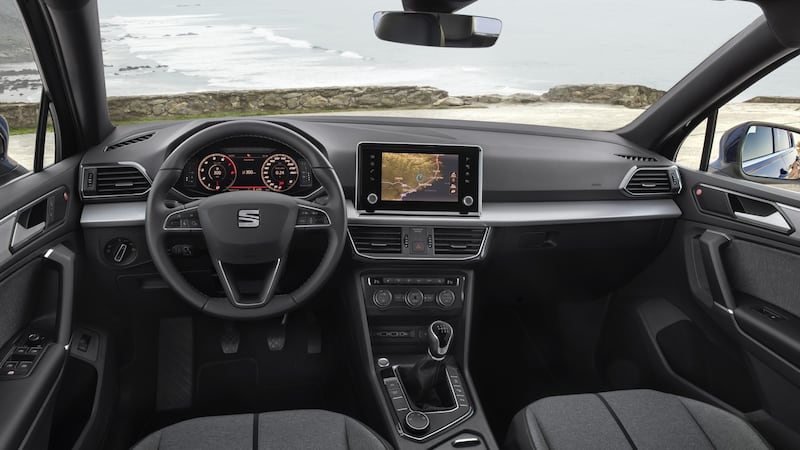Given that, in spite of the rugged SUV shape, most Seat Tarracos will spend most of their lives shunting along in urban traffic, it seems odd that this particular version was so dull to drive at low speeds. A shame too, as in other aspects the Tarraco was turning out to be a rather nice car.
The problem is one that we have experienced with other VW Group products using the ubiquitous combo of 2.0-litre 190hp TDI diesel engine and seven-speed DSG automatic gearbox.
It happens when you go to pull away from either a standstill or from low speeds – press the accelerator and nothing much happens. Press it harder and still nothing happens. Press yet harder, and suddenly the engine wakes up, revs hard, and shunts you forward with a distinct lack of elegance.
This isn’t just an issue of looking like a dopey learner driver. If you’ve got the Tarraco’s driving mode selector switched to Eco (and why wouldn’t you? We all like to save a bit of fuel) then this low-rev sluggishness becomes positively dangerous.
On more than one occasion, pulling out of a busy junction or merging on to a hectic roundabout became a heart-in-mouth operation, with the big Seat seeming to hang, endlessly, waiting for power to start flowing. Switching to normal or even Sport modes only partly improved matters.
It’s a shame as until this particular aspect started to bug me the Tarraco was rather growing on me.
I had expected it to be yet another identikit variation on the VW Group mid-size seven-seat SUV platform – if you’ve driven a VW Tiguan Allspace or a Skoda Kodiaq, what, pray, would be the point of getting excited about a Tarraco? It’s basically the same, right?
Personality
Well, yes, right. It is, and yet the minute nuances of VW’s parts-bin planning mean that the Tarraco has managed to find a sliver of a gap into which to wedge its own personality.
I reckon it’s the best looking of the three cars, and by quite some margin. Oh, you can easily (and rightly) accuse it of being all but indistinguishable from the Tiguan from the side. It’s true too that my eldest son accidentally climbed into the back of someone else’s car while I was waiting for him outside a shop. In his defence, it was the same colour.
Even so, I think the Tarraco’s face is the most handsome, and it’s certainly a little more distinctive than those of the Tiguan or the Kodiaq.
There’s something similar happening on the inside too. As you’d expect, everything looks and feels familiar if you’ve stepped out of another VW Group product – no surprises – but the Tarraco’s combo of comfort, space, and just a modicum of style (the semi-floating central eight-inch touchscreen, for instance) lift it just a hair above its internal competition from VW and Skoda.
There's buckets of space too, at least in rows one and two. As ever with such cars, space in row three is rather more theoretical than actual, but then if you really cared about ultimate seat space, you'd buy Seat's similarly-priced Alhambra MPV, which – thankfully – remains on sale alongside the Tarraco rather than being replaced by it.
Pricing for the Tarraco causes a little head scratching. The cheapest one is a 1.5 TSI petrol SE version for €34,700 and to get seven seats you’ll have to add another €1,000. (Just as you do with the VW and Skoda. Why? Rivals like the Peugeot 5008 have seven as standard).
A base Kodiaq is cheaper (€32,495 for a 1.5 TSI Active) but the Seat punches back with lots of standard equipment – 18-inch wheels, that big eight-inch touchscreen, LED headlamps and more – that lift it above the Skoda in the toy stakes.
Safety score
Then there’s the fact that Seat can now shout that the Tarraco boasts a safety score that is only bettered in its segment by Volvo – a 97 per cent adult occupant rating on the Euro NCAP crash test, compared to the Volvo XC60’s 98 per cent. Oddly, the Kodiaq is behind on 92 per cent adult protection rating, while the Seat scores 84 per cent in child protection, compared to the Skoda’s 77 per cent.
To drive the Tarraco feels – again unsurprisingly – rather similar to both the Tiguan and the Kodiaq. I say “rather” because there are some infinitesimal differences, and they are in the Seat’s favour. It has steering that feels a touch sharper and more responsive than the VW’s, while the ride quality seemed a tiny bit better than the Skoda’s.

But we are splitting hairs. All three cars are pretty much equal in their endeavours, and probably indistinguishable (that word again) to most of us. VW’s parts-sharing policy has given us more choice, but less variation.
That lack of variation wouldn’t matter so much if it was all upside, but the Tarraco suffers from that same hesitancy that we’ve seen – and been both annoyed and concerned by – in other VW Group vehicles, and it too shares the extra cost of a seven-seat version, which seems rather foolish when the Peugeot 5008 is lurking with its standard seven perches.
THE LOWDOWN
Seat Tarraco Xcellence 2.0 TDI 190 4Drive DSG
Power: 190hp.
Torque: 400Nm.
0-100kmh: 8.0sec.
Top speed: 210km/h.
Claimed economy: 7.0 litres/100km (40.3mpg).
CO2 emissions: 196g/km*.
Motor tax: €390.
Price: €59,014 as tested; Tarraco starts at €34,700;
Verdict: Tarraco looks smart and is pleasant, but needs better low-down performance.
Our rating: 3/5














